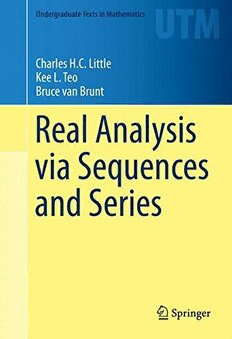Table Of ContentUndergraduate Texts in Mathematics
Charles H.C. Little
Kee L. Teo
Bruce van Brunt
Real Analysis
via Sequences
and Series
Undergraduate Texts in Mathematics
Undergraduate Texts in Mathematics
SeriesEditors:
SheldonAxler
SanFranciscoStateUniversity,SanFrancisco,CA,USA
KennethRibet
UniversityofCalifornia,Berkeley,CA,USA
AdvisoryBoard:
ColinAdams,WilliamsCollege
DavidA.Cox,AmherstCollege
PamelaGorkin,BucknellUniversity
RogerE.Howe,YaleUniversity
MichaelOrrison,HarveyMuddCollege
JillPipher,BrownUniversity
FadilSantosa,UniversityofMinnesota
Undergraduate Texts in Mathematics are generally aimed at third- and fourth-
year undergraduate mathematics students at North American universities. These
texts strive to provide students and teachers with new perspectives and novel
approaches.Thebooksincludemotivationthatguidesthereadertoanappreciation
ofinterrelationsamongdifferentaspectsofthesubject.Theyfeatureexamplesthat
illustratekeyconceptsaswellasexercisesthatstrengthenunderstanding.
Moreinformationaboutthisseriesathttp://www.springer.com/series/666
Charles H.C. Little • Kee L. Teo (cid:129) Bruce van Brunt
Real Analysis via Sequences
and Series
123
CharlesH.C.Little KeeL.Teo
ResearchFellowandformer ResearchFellowandformer
ProfessorofMathematics AssociateProfessorofMathenatics
InstituteofFundamentalSciences InstituteofFundamentalSciences
MasseyUniversity MasseyUniversity
PalmerstonNorth,NewZealand PalmerstonNorth,NewZealand
BrucevanBrunt
AssociateProfessorofMathematics
InstituteofFundamentalSciences
MasseyUniversity
PalmerstonNorth,NewZealand
ISSN0172-6056 ISSN2197-5604 (electronic)
UndergraduateTextsinMathematics
ISBN978-1-4939-2650-3 ISBN978-1-4939-2651-0 (eBook)
DOI10.1007/978-1-4939-2651-0
LibraryofCongressControlNumber:2015935731
Mathematics Subject Classification (2010): 26-01, 03E15, 40A05, 26A03, 26A15, 26A24, 26A42,
40A30,26A18
SpringerNewYorkHeidelbergDordrechtLondon
©SpringerScience+BusinessMediaNewYork2015
Thisworkissubjecttocopyright.AllrightsarereservedbythePublisher,whetherthewholeorpartof
thematerialisconcerned,specificallytherightsoftranslation,reprinting,reuseofillustrations,recitation,
broadcasting,reproductiononmicrofilmsorinanyotherphysicalway,andtransmissionorinformation
storageandretrieval,electronicadaptation,computersoftware,orbysimilarordissimilarmethodology
nowknownorhereafterdeveloped.
Theuseofgeneraldescriptivenames,registerednames,trademarks,servicemarks,etc.inthispublication
doesnotimply,evenintheabsenceofaspecificstatement,thatsuchnamesareexemptfromtherelevant
protectivelawsandregulationsandthereforefreeforgeneraluse.
Thepublisher,theauthorsandtheeditorsaresafetoassumethattheadviceandinformationinthisbook
arebelievedtobetrueandaccurateatthedateofpublication.Neitherthepublishernortheauthorsor
theeditorsgiveawarranty,expressorimplied,withrespecttothematerialcontainedhereinorforany
errorsoromissionsthatmayhavebeenmade.
Printedonacid-freepaper
SpringerScience+BusinessMediaLLCNewYorkispartofSpringerScience+BusinessMedia(www.
springer.com)
Preface
Thisbookisatextonrealanalysisforstudentswithabasicknowledgeofcalculus
of a single variable. There are many fine works on analysis, and one must ask
what advantages a new book brings. This one contains the standard material for
a first course in analysis, but our treatment differs from many other accounts in
thatconceptssuchascontinuity,differentiation,andintegrationareapproachedvia
sequences.Themainanalyticalconceptisthustheconvergenceofasequence,and
thisideaisextendedtodefineinfiniteseriesandlimitsoffunctions.Thisapproach
not only has the merit of simplicity but also places the student in a position to
appreciate and understand more sophisticated concepts such as completeness that
playacentralpartinmoreadvancedfieldssuchasfunctionalanalysis.
The theory of sequences and series forms the backbone of this book. Much of
the material in the book is devoted to this theory and, in contrast to many other
texts, infinite series are treated early. The appearance of series in Chap. 3 has the
advantages that it provides many straightforward applications of the results for
sequences given in Chap. 2 and permits the introduction of the elementary tran-
scendentalfunctionsasinfiniteseries.Thedisadvantageisthatcertainconvergence
testssuchastheintegraltestmustbepostponeduntiltheimproperintegralisdefined
inChap.7.TheCauchycondensationtestisusedinChap.3totackleconvergence
problemswheretheintegraltestisnormallyapplied.Althoughmuchofthematerial
in Chap. 2 is standard, there are some unusual features such as the treatment of
harmonic, geometric, and arithmetic means and the sequential definition of the
exponential function. In Chap. 3 we present results, such as the Kummer–Jensen
test,Dirichlet’stest,andRiemann’stheoremontherearrangementofseries,thatare
oftenpostponedornottreatedinafirstcourseinanalysis.
Limits of functions are introduced in Chap. 4 through the use of convergent
sequences,andthisconceptisthenusedinChaps.5and6tointroducecontinuity
anddifferentiation.Aswithanyanalysisbook,resultssuchastheintermediate-value
theoremandthemean-valuetheoremcanbefoundinthesechapters,butthereare
also some other features. For instance, the logarithm is introduced in Chap. 5 and
thenusedtoproveGauss’stestforinfiniteseries.InChap.6wepresentadiscrete
v
vi Preface
versionofl’Hôpital’srulethatisseldomfoundinanalysistexts.Weconcludethis
chapterwithashortaccountofthedifferentiationofpowerseriesusingdifferential
equationstomotivatethediscussion.
The Riemann integral is presented in Chap. 7. In the framework of elementary
analysis this integral is perhaps more accessible than, say, the Lebesgue integral,
anditisstillanimportantconcept.Thischapterfeaturesanumberofitemsbeyond
the normal fare. In particular, a proof of Wallis’s formula followed by Stirling’s
formula, and a proof that (cid:2) and e are irrational, appear here. In addition, there is
alsoashortsectiononnumericalintegrationthatfurtherillustratesthedefinitionof
theRiemannintegralandapplicationsofresultssuchasthemean-valuetheorem.
Chapter 8 consists of a short account of Taylor series. Much of the analytical
apparatusforthistopicisestablishedearlierinthebooksothat,asidefromTaylor’s
theorem, the chapter really covers mostly the mechanics of determining Taylor
series.Thereisanextensivetheoryonthistopic,anditisdifficulttolimitoneselfso
severelytothesebasicideas.Here,despitethebook’semphasisonseries,theauthors
eschewtopicssuchasthetheoremsofAbelandTauberand,moreimportantly,the
questionofwhichfunctionshaveaTaylorseries.Afullappreciationofthistheory
requirescomplexanalysis,whichtakesustoofarafield.
The student encounters Newton’s method in a first calculus course as an
application of differentiation. This method is based on constructing a sequence,
motivated geometrically, that converges (hopefully) to the solution of a given
equation. The emphasis in this first encounter is on the mechanics of the method
and choosing a sensible “initial guess.” In Chap. 9 we look at this method in the
widercontextofthefixed-pointproblem.Fixed-pointproblemsprovideapractical
applicationofthetheoryofsequences.ThesequenceproducedbyNewton’smethod
isalreadyfamiliartothestudent,andthetheoryshowshowproblemssuchaserror
estimatesandconvergencecanberesolved.
Thefinalchapterdealswithsequencesoffunctionsanduniformconvergence.By
this stage the reader is familiar with the example of power series, but those series
have particularly nice properties not shared generally by other series of functions.
Thematerialismotivatedbyaproblemindifferentialequationsfollowedbyvarious
examples that illustrate the need for more structure. This chapter forms a short
introductiontothefieldandismeanttoprimethereaderformoreadvancedtopics
inanalysis.
Anintroductorycourseinanalysisisoftenthefirsttimeastudentisexposedto
the rigor of mathematics. Upon reflection, some students might even view such a
course as a rite of passage into mathematics, for it is here that they are taught the
need for proofs, careful language, and precise arguments. There are few shortcuts
to mastering the subject, but there are certain things a book can do to mitigate
difficultiesandkeepthestudentinterestedinthematerial.Inthisbookwestriveto
motivatedefinitions,results,andproofsandpresentexamplesthatillustratethenew
material. These examples are generally the simplest available that fully illuminate
the material. Where possible, we also provide examples that show why certain
conditions are needed. A simple counterexample is an exceedingly valuable tool
Preface vii
forunderstandingandrememberingaresultthatisladenwithtechnicalconditions.
There are exercises at the end of most sections. Needless to say, it is here that the
studentbeginstofullyunderstandthematerial.
Theauthorsappreciatetheencouragementandsupportoftheirwives.Theyalso
thank Fiona Richmond for her help in preparing the figures. The work has also
benefitedfromthethoughtfulcommentsandsuggestionsofthereviewers.
PalmerstonNorth,NewZealand CharlesH.C.Little
KeeL.Teo
BrucevanBrunt
Contents
1 Introduction................................................................. 1
1.1 Sets.................................................................... 1
1.2 OrderedPairs,Relations,andFunctions ............................ 2
1.3 InductionandInequalities ........................................... 5
1.4 ComplexNumbers ................................................... 14
1.5 FiniteSums........................................................... 23
2 Sequences.................................................................... 33
2.1 DefinitionsandExamples............................................ 33
2.2 ConvergenceofSequences........................................... 37
2.3 AlgebraofLimits..................................................... 43
2.4 Subsequences......................................................... 53
2.5 TheSandwichTheorem.............................................. 55
2.6 TheCauchyPrinciple ................................................ 65
2.7 MonotonicSequences................................................ 77
2.8 UnboundedSequences............................................... 104
3 Series......................................................................... 109
3.1 Introduction........................................................... 109
3.2 DefinitionofaSeries................................................. 110
3.3 ElementaryPropertiesofSeries ..................................... 117
3.4 TheComparisonTest................................................. 121
3.5 Cauchy’sCondensationTest......................................... 123
3.6 TheLimitComparisonTest.......................................... 127
3.7 TheRatioTest........................................................ 132
3.8 TheRootTest......................................................... 136
3.9 TheKummer–JensenTest............................................ 141
3.10 AlternatingSeries .................................................... 147
3.11 Dirichlet’sTest ....................................................... 152
3.12 AbsoluteandConditionalConvergence............................. 156
3.13 RearrangementsofSeries............................................ 160
3.14 ProductsofSeries .................................................... 165
ix

